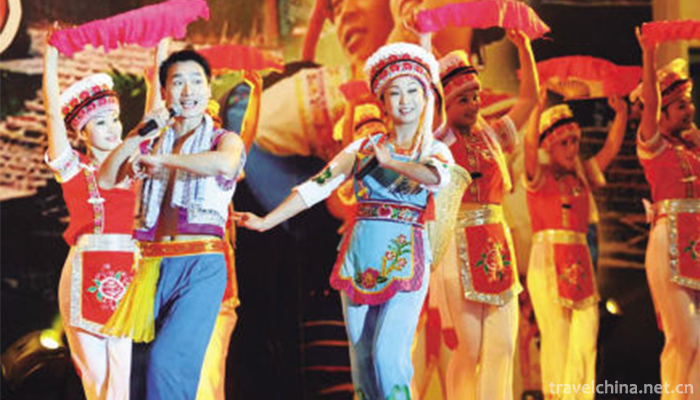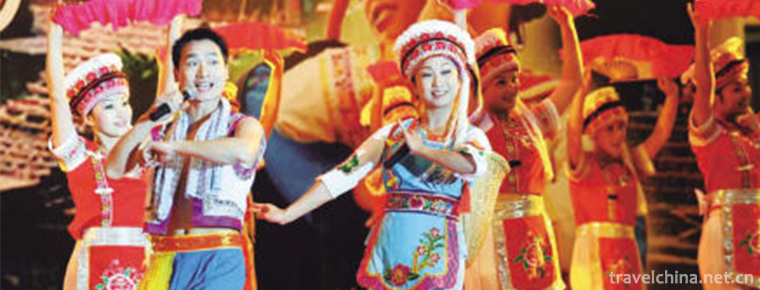Sangzhi Folk Song
Sangzhi Folk Song
Sangzhi Folk Song, a local traditional music in Sangzhi County, Hunan Province, is one of the national intangible cultural heritage.
Sangzhi folk song originated from the ballads of the ancestors'daily production and life in the primitive farming period. It is a kind of folk music culture created, Sung and accumulated by the people of Sangzhi County in Hunan Province in the long-term life practice. It has a history of more than 2000 years. Sangzhi folk song has a lively rhythm, beautiful melody, rich melody and various forms. With its unique lining and lining, it shows simple, sincere feelings and exciting chords, which is deeply favored by composers.
On May 20, 2006, Sangzhi Folk Song was approved by the State Council of the People's Republic of China to be included in the first batch of national intangible cultural heritage list, item number: II-10.
historical origin
Sangzhi folk songs originated from the songs of the ancestors'daily production and life in the primitive farming period. Since the founding of New China, the Party and the government have been very concerned about the economic development of minority areas, attached great importance to the excavation, collation and improvement of national culture, and successively organized relevant personnel to rescue and collate Sangzhi folk songs.
Cultural characteristics
Sangzhi folk song has a lively rhythm, beautiful melody, rich melody and various forms. With its unique lining and lining, it shows simple, sincere feelings and exciting chords, which is deeply favored by composers.
Sangzhi folk songs are rich in structure, diverse melodies, many scales and modes, and more modified lyrics.
Sangzhi's folk song style includes half-sentence style, one-sentence style, two-sentence style, three-sentence style, Four-Sentence style, five-sentence style, six-sentence style, seven-sentence style and wearing songs, etc.; "repetition" and "conjunction" are its usual melody creation techniques, and also have original skills, such as "compression", i.e. rhythm contraction; "lengthening" is the extension of rhythm; "teasing" is a certain established folk song phrase. Insert new factors in the middle; "Zhuba" means adding new melodies before or after a given phrase or paragraph to form a melodic expansion; "float" means that the melody moves upwards; and "sink" means that the melody moves downwards. In addition, there are "leave head to tail", "leave head to tail", "change pattern", "dig liver to lung" and other techniques, and the melody is mostly decorated with Boeing, leaning, sliding, etc.
In terms of scale mode, Sangzhi folk songs are mainly composed of "five-tone characteristic mode" and "five-tone feather mode". There are also a few other Palace mode, quotient mode, angular mode and special scales with deviation, such as "four-tone feather mode", "four-tone characteristic mode" and "four-tone characteristic mode" with deviation, such as "clear angle" or "seven" (changing palace).
In terms of lyrics, Sangzhi folk songs often use literary rhetoric techniques such as metaphor and parallelism, and adorn them with a large number of local characteristics, such as lining words, lining words and Erhua sounds, which have strong national style and high artistry.
Sangzhi folk songs are mainly composed of Sangzhi dialect with a heavy roll of tongue. Its singing voice is primitive and rough, which is the unique personality of Sangzhi people formed in the long-term blocked living environment. In singing, Sangzhi's folk songs show infinite charm in depicting musical image, revealing the inner world of the singer, conveying people's thoughts and feelings, and setting off the atmosphere of the environment, and make Sangzhi's folk songs have high aesthetic value.
Subject works
Sangzhi's folk songs are of various genres, various repertoires and rich contents. There are high and bright folk songs, the repertoire is "Bugu", "Cold water brewing tea slowly thick", "the world is only the most precious" and more than 1400 branches, which belong to three categories: high-pitched, low-pitched and flat-pitched.
There are nearly 300 interesting and lively tunes, such as "Upper Sichuan", "Snow Seeing the Sun in the Air", "When I Watch the Flowers of Sophora japonica" and so on. They can be divided into love songs reflecting love life, misery songs reflecting miserable life and seasonal minors recording production and life.
There are more than 140 inspiring slogans, including "Yaoshui oar slogan", "Prying stone slogan", "Bearing the burden slogan", "Picking up the moth's eyebrow moon in the middle" and so on, which are included in the four categories of "Yaoshui slogan", "Rock Worker's slogan", "Handling slogan" and "Grass slogan".
There are warm and cheerful lantern tunes. The repertoire includes "Happy Lantern Playing", "Four Seasons Flowers Blooming", "Flowers and Trees Entangling Me and Entangling Him" and more than 130 pieces.
According to the form of performance, there are literary lanterns, martial arts lanterns, ugly lanterns, jumping lanterns, lazy lanterns and so on. If we start from the subject matter, we can divide it into three categories: singing lamp tune, flower lamp praise and love song.
There are more than 80 revolutionary red songs with more and more fighting spirit, such as "General Helong arrives", "Hang a lamp at the door", "Be a soldier, be a Red Army", "Strength of the Peasant Association" and so on.
According to the content of the performance, it can be divided into four categories: celebrating the Dragon song, military and civilian love song, celebrating the Red Army song and celebrating the peasant movement.
There are naive children's songs, including "Catching Crabs" and "Counting Toads" and dozens of other works.
There are folk ritual songs with strong folk customs. There are about 360 works, such as "Worship for ancestors" and "Crying for the Dead", which belong to Nuo tune, marriage song, Bai origin song and elegy.
In addition, there are a few natural and quiet lullabies, such as "The Red Army Comes to Be the Master"; folk songs of various genres, such as "Car Lamp is Strange" (Car Lamp), "Sangzhi Helong" (Three-stick Drum), "Wind and Rain Become Happy in the Year" (Nine-stick Whip) and "Congratulations on the Lord's Eastern Hobby House Farm" (Lotus Lotus Lotus Lotus Lotus Lotus Lotus Lotus Lotus Lotus Lotus Loud).
Inheritance and Protection
Inheritance value
Sangzhi folk song shows its unique artistic charm in singing aloud and murmuring. Generally speaking, it has two values:
(i) Social and cultural aspects
Sangzhi folk song is the product of Sangzhi's unique geographical environment and closed and semi-closed living condition. Up to now, there are still many ballads reflecting primitive religions (such as Nuoqiang, hay gongs and drums). The Lyric structure of the three sentences provides precious information and examples for the study of the diversity of Chinese folk songs, which embodies the simple philosophy of Sang Zhiren's worship of "three".
(2) Artistic features
Sangzhi folk songs are divided into folk songs, minor tunes, etiquette songs, Nuo tune and so on, covering a variety of traditional folk songs. Its rigorous structure and various forms of music, especially the use of the lining words, make folk songs reach a very high artistic realm in setting off the atmosphere and revealing the inner feelings of the characters.
In addition, Sangzhi folk song's special moistening method and air-voice singing skills greatly enrich the theory of folk song singing and provide a unique example for vocal music singing.
Heritage figures
Shangshengwu, male, in April 2018, Shangshengwu was selected as the fifth batch of representative inheritors of national intangible cultural heritage projects, declaring the area: Sangzhi County, Hunan Province.
Tang Guizhen, female, was born in Xian'e Village, Liyuan Town, Sangzhi in August 1977. She is the representative inheritor of Sangzhi Folk Song Project at the municipal level.
Zhang Jiaqing, male, Tujia nationality, was born in 1973 in Damutang Village, Shataping Township, Sangzhi County. He is the representative inheritor of Sangzhi Folk Song Project at the municipal level.
protective measures
In 2008, Sangzhi County was named "Town of Chinese Folk Songs" by the Chinese Artists Association, which better protected the inheritance of Sangzhi Folk Songs.
On November 8, 2017, the finals of Sangzhi Folk Song King were held in Shuoziqiu, Bai Nationality Township, Mahekou, Sangzhi County. The finals of Sangzhi Folk Song King 2017 were held nationwide. It is the first national culture of Sangzhi Folk Song to learn and implement the spirit of the Nineteenth National Congress of the CPC, to promote the brand of Sangzhi Folk Song, to enhance the influence of Sangzhi Folk Song, to develop the industry of Sangzhi Folk Second good publicity and inheritance.
social influence
Important activities
On November 10, 2017, the literary and artistic performance of Zhangjiajie Sangzhi Folk Song Festival was held at Helong Stadium in Sangzhi County. The inheritors of Sangzhi Old Folk Songs jointly sang Sangzhi's original ecological folk songs.
Honorary recognition
In October 2005, Sangzhi Folk Song was named "Ten National Folk Cultural Heritage of Hunan Province".
In 2011, Sangzhi Folk Song was rated as "Ten Most Charming Non-Heritage Items in Hunan Province".


-
1.Putuo Mountain Scenic Spot
Putuo Mountain Scenic Spot, located about 100 nautical miles east of Hangzhou Bay, Zhejiang Province, is an island in Zhoushan Islands. The island covers an area of 12.5 square kilometers
Time 2018-12-07 -
2.Huaxi Qingyan Ancient Town Scenic Area
Qingyan Ancient Town, one of the four ancient towns in Guizhou, is located in the southern suburb of Guiyang City. It was built in Hongwu ten years (1378) of Ming Dynasty and was formerly a military f
Time 2018-12-12 -
3.Linzhi Basongcuo Scenic Area
Basongtao, also known as Caogao Lake, means "green water" in Tibetan. It is about 18 kilometers long. Its surface area is about 27 square kilometers.
Time 2018-12-12 -
4.Eight polar boxing
Bajiquan is a kind of boxing in Chinese Wushu. The word "eight poles" of this boxing method originated from the concept of Palaeogeography and originated from the Han Dynasty
Time 2019-04-02 -
5.Huizhou folk songs
Huizhou folk song is an ancient traditional folk art in Huizhou area. It is rich in content and diverse in genres, including chants, folk songs, minors, Buddhist and Taoist songs,
Time 2019-05-04 -
6.Huian stone carving
Hui'an stone sculpture mainly served religion in its early stage, with strong religious color. It is mainly embodied in the architectural design, sculpture and installation of the temple,
Time 2019-05-05 -
7.72 Sorcery Music of Lingyun Zhuang Nationality
The 72 witchcraft tunes of Lingyun Zhuang nationality originated in Lingyun County, Guangxi, mainly centered on Sicheng Town, where the county government is located. It is a tune sung by the Zhuang wi
Time 2019-05-13 -
8.Turkish Pan Embroidery
Pan embroidery is the most important embroidery method in Chinese Tu embroidery, and it is a compulsory course for Tu women in their lifetime. Pan embroidery is a unique embroidery method of the Tu na
Time 2019-06-23 -
9.Yidege Ink Making Skills
Yidege is a local traditional handicraft in Beijing. It is well-known for producing ink. The products have bright ink, rich and light colors, fluent writing, moderate concentration, strong fragrance,
Time 2019-07-11 -
10.Zhangjiajie Yangxi Opera
Zhangjiajie Yangxi Opera originated in the middle of Qing Dynasty and has a history of more than 300 years. It belongs to Beilu Yangxi Opera. The singing feature is the singing method of "golden
Time 2019-07-16 -
11.Leshan medical and health
By the end of 2018, Leshan City had 3259 health institutions (including village clinics). Among them, there are 102 hospitals, 207 health centers, 12 maternal and child health centers (stations, stations), 12 centers for Disease Control and prevention, 12 health
Time 2020-12-17 -
12.History and culture of Yibin
Yibin has 34 world-class, national and provincial scenic spots and 58 national and provincial key cultural relics protection units. Among them, there are seven cave cliff tombs (Eastern Han Dynasty), Jiuzhou tower (Song Dynasty), Daguanlou (Qing Dynasty), etc.
Time 2020-12-18